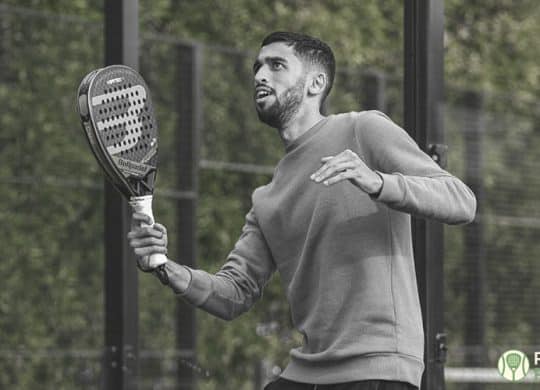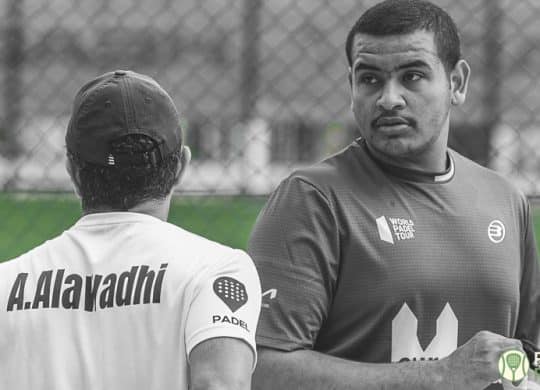Types of padel tennis flooring: Court details
Currently, players can play padel tennis on four specific types of flooring. These flooring materials differ drastically and require a varied set of maintenance techniques. Perhaps, there is more to understand about these different types of padel floors, which is why we have elaborated on them below.
- Padel tennis Artificial turf flooring
- Cement padel tennis flooring
- Synthetic resin padel tennis flooring
- Padel tennis porous concrete flooring
Padel tennis Artificial turf flooring
Artificial turf is one of the most commonly used forms of padel tennis flooring. As per experts, padel tennis played on artificial grass provides improved performance.
Many professional players have stated positive responses regarding their experience playing on artificial turfs. The benefits of playing on artificial turf are that it offers better cushioning and a slower pace.
Playing on artificial grass reduces the risk of injury compared to other types of padel tennis flooring. These factors make artificial turf a desirable surface for padel players to play on.
There are various kinds of artificial grass that you can find in padel courts. The most popular ones are polyethylene and polypropylene materials.
Cement padel tennis flooring
Right off the bat, you know that cement padel tennis flooring is relatively more rigid and more durable than other forms of padel flooring. It is most suitable for professional padel players to play on and is the least preferred choice for beginners.
A cement padel tennis flooring creates more bounce and a faster pace. It is considered very difficult to play padel on a cement court. However, despite having certain drawbacks, cement padel floors still exist in courts for players who enjoy an adrenaline-packed performance.
Spectators of the sport, in many instances, have shared their displeasure of witnessing padel matches played on cement courts. The most common feedback we have received is that the ball’s bounce is too fast, making it difficult for players to strike.
Synthetic resin padel tennis flooring
Synthetic resin flooring is the most favorable type of padel tennis flooring. You will find this type of flooring used in various padel tournaments around the world.
One of the most commonly used synthetic resin flooring types is rubber-bonded resin. This particular surface provides both slow and fast-paced bounce friction. A synthetic resin court is relatively easier to maintain when compared to cement and porous concrete padel tennis flooring.
Padel tennis porous concrete flooring
Porous concrete is another hard surface court flooring material that many padel players prefer playing on. What differentiates porous concrete from regular concrete is its ability to absorb water.
Regarding regular concrete, sand is an essential component of the mixture. On the other hand, porous concrete does not have a mixture of sand in it. Thus, the lack of sand means an increased number of pores, which helps drain water and keep the surface dry.
Porous cement courts are also among the other flooring types that provide excellent stability and grip to a padel player.
Maintaining padel court flooring
In order to gain the best results while playing padel, a padel court flooring must be well maintained. All forms of padel tennis flooring have their specific way of maintenance.
Therefore, we have listed out some of the basic aspects that padel court managements undertake to maintain its flooring condition.
- Periodic cleaning
- Wear non-marking sole shoes
- Fungal removal
- Sand distribution
Periodic cleaning
Maintaining a clean court is essential. Whether an artificial turf or a porous concrete court, all types of padel tennis flooring require periodic cleaning. Any residue on the surface can cause players to lose grip and alter how they play the game.
Padel floors must be cleaned every week to maintain their condition and ensure player safety.
Wear non-marking sole shoes
Every floor has a specific shoe type recommended for safe play. Padel shoes with non-marking soles are considered the best option for playing padel across most floor types.
Other shoes may cause scratches and wear and tear on the padel court surface. Therefore, you can use a non-marking sole padel shoe to avoid such damage to the court.
As a side note, you should also remember that using the right padel shoes can protect you while playing. It can avoid slips and damage to muscles.
Fungal removal
There are high chances of accumulating fungus and moss, especially if the court is not regularly cleaned. While playing padel, players might be exposed to injuries if the court surface contains fungal patches.
Therefore, a padel tennis floor with fungal patches must be cleaned using fungicide substances to avoid such scenarios. You must note that the fungicide used should not contain any oil-based elements.
Sand distribution
Redistributing sand on padel court surfaces is another way of maintaining its grip and condition. It is done using specialized equipment that ensures an equal distribution of sand throughout the court.
You don’t want uneven patches of sand across the court to negatively impact your game. Hence, you must follow tried and tested methods to distribute sand across the surface of the padel court.
How big is a padel tennis flooring?
The dimensions of a padel court floor are 20 meters long and 10 meters wide. It is surrounded by glass walls or wired net walls that span a maximum of 4 meters in height (at the ends).
Does padel flooring affect the way you play?
Yes. Padel flooring does affect the way you play. As we have discussed above, padel tennis flooring materials are different. You know that every surface has its characteristics.
These variations are the ones that impact the way you play. For instance, a cement surface causes the ball to bounce too much and creates a faster pace for your ball.
On the other hand, artificial turf has a slower pace. Therefore, professional and beginner players have their own preferences for court surfaces before playing christmas inflatable nz.
Padel tennis flooring: An integral part of playing padel
In this article, we have provided you with all the information regarding padel tennis flooring, their types and the impact of playing on different surfaces. Perhaps, if you want to experience this for yourself, you can come into one of our padel court facilities and enjoy a game of padel.






